Journal of Environmental Protection
Vol. 3 No. 6 (2012) , Article ID: 20043 , 7 pages DOI:10.4236/jep.2012.36057
Removal of Steriod Hormones by Activated Carbon Adsorption—Kinetic and Thermodynamic Studies
![]()
Department of Geography, Environment and Society, Coventry University, Coventry, UK.
Email: A.Ifelebuegu@coventry.ac.uk
Received March 19th, 2012; revised April 15th, 2012; accepted May 11th, 2012
Keywords: Adsorption; Isotherms; 17β-Estradiol; 17α-Ethinyloestradiol; Enthalpy
ABSTRACT
The mechanism, isotherms and kinetics of removal of two endocrine disrupting chemicals, 17β-estradiol (E2) and 17α- ethinyloestradiol (EE2) by activated carbon adsorption were investigated in an agitated non-flow batch adsorption studies. Mathematical models were used to describe the adsorption phenomenon with the kinetic and thermodynamic parameters evaluated using the adsorption equilibrium data at varying temperatures. Higher adsorption rates were achieved at acidic to neutral pH ranges, with the sorption kinetic data showing a good fit to the pseudo second order rate equation and the Langmuir adsorption isotherm model for both E2 and EE2. The Gibbs free energy were –16.68 kJ/mol and –17.34 kJ/mol for E2 and EE2 respectively. The values of enthalpy for both E2 (84.50 kJ/mol) and EE2 (90 kJ/mol) indicated a chemical nature of the sorption process. Both the isotherm and thermodynamic data obtained all supported the mechanism of adsorption of E2 and EE2 to be mainly chemisorptions supported by some physical attractions.
1. Introduction
There are great concerns among environmentalist of the presence of a large number of chemicals in the environment described as endocrine disrupting chemicals (EDCs). These chemicals consist of synthetic and natural chemicals which affect the stability of normal hormonal functions in humans. They are mainly discharged to the environment through effluent from wastewater treatment works [1-3]. Several studies have shown that humans and wildlife are exposed to a combination of multiple agents of EDCs and their effects are versatile in both mammalian and non-mammalian species due to their various sources and how they are discharged to the environment [4,5]. The steroid hormones like 17β-estradiol (E2) 17α- ethinylestradiol (EE2), alkyl phenols, alkyl phenol ethoxylates and bisphenol A are among the most potent EDCs found in environmental waters.
In view of these concerns, there have been various researches across the globe assessing the fate and removal of these chemicals in wastewater treatment processes as the conventional treatment methods are not efficient in removing the compounds to levels below their potentially non effect concentrations. Various methods have been assessed including granular activated carbon adsorption [6-8], and other novel absorbents have shown potentials [9-12]. The use of various advance chemical oxidation processes and membrane processes have also been investigated [13-16]. Use of activated carbon is favoured by many as it has been used extensively for treatment of portable water and there is no concern of by-product formation as with most advanced chemical oxidation processes [11]. The use of GAC adsorption for treatment of wastewater is likely going to become prominent in the UK water industry in the near future.
In this study the kinetics and thermodynamic properties of the adsorption of E2 and EE2 unto activated carbon were investigated to inform the modelling and design of full scale adsorption processes for wastewater treatment applications.
2. Material and Methods
2.1. Chemicals
All chemicals used in the study were of analytical grade. E2 and EE2 were obtained from Sigma Aldrich, Gillingham, UK. Stock solutions of the EDCs were prepared by dissolving accurate weights of the compounds in HPLC grade methanol (Fisher Scientific, UK). The activated carbons used in these experiments were supplied by Jacobi Carbons (Merseyside, UK). All the carbons were dried in an oven for 3 hours at 150˚C before use. The characteristics of the activated carbon were determined according to standard methods [17], and are shown in Table 1.

Table 1. GAC characterisation.
2.2. Batch Experiments
Batch adsorption experiment using the bottle point method was performed at temperatures ranging from 15˚C to 35˚C for adsorption Isotherm test, varying weights of the granular activated carbon (0.05 g - 0.8 g) were added to 200 ml of E2 and EE2 aqueous solutions in 250 ml plugged conical flasks. The experiments were conducted at pHs 4, 6, 7, 8 and 10. The aqueous mixtures were agitated at a constant rate of 250 rpm. The experiments were conducted for 180 mins initially and subsequently for 120 mins. Samples were withdrawn at fixed time intervals for chemical analysis. The experimental data obtained were analysed using various kinetic models: Legergren pseudo first-order kinetics, pseudo second order kinetics, intra-particle diffusion kinetic model and the Langmuir and Freundlich adsorption isotherm models. The thermodynamic parameters which include Gibb’s free energy, enthalpy and entropy were also investigated.
2.3. Analytical Procedures
E2 and EE2 were analysed by LC-MS/MS using the Hewlett Packard 1100LC and an Applied Biosystems API5000 mass spectrometer using negative ion electrospray in multiple reaction monitoring mode. Details of the analytical methods have been described elsewhere [18, 19].
3. Results and Discussion
3.1. Effects of pH
The effects of pH on the adsorption of E2 and EE2 were determined by batch adsorption experiments at varying pH values of 4, 6, 7, 8 and 10, with all other experimental variables kept constant (2 mg/l E2 and EE2; temperature, 25˚C ± 2˚C; adsorbent dose, 0.5 g). The effects of pH on E2 and EE2 adsorption are illustrated in the Figure 1. It can be seen that the pH values had significant effects on the adsorption process. The percentage efficiency was better in the acidic and neutral pH ranges, and lowest in the alkaline pH ranges. pH values affect the surfaces charges on activated carbon. With pKa values
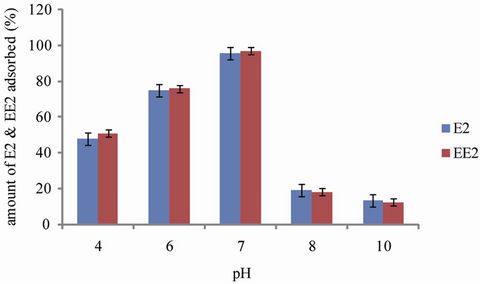
Figure 1. Percentage of E2 and EE2 adsorbed at varying pH.
of E2 and EE2 being 10.4 and 10.7 respectively [20]; at lower and neutral pHs (4, 6 and 7) both E2 and EE2 are neutral and exist in non-ionic molecular form and can easily be adsorbed onto the GAC. Whereas, at higher pHs (8 and 10), the carbon particles are negative and hence reduce the sorption process by electrostatic repulsion. It is also known that an increase in hydroxyl ion at the higher pHs results in the production of aqua-complexes [21,22], which reduces the adsorption capacities of the activated carbon.
3.2. Effect of Adsorbent Dose
The effect of varying doses of the GAC was investigated for E2 and EE2 with other experimental parameters left constant (2 mg/l E2 and EE2; temperature, 25˚C ± 2˚C; adsorbent dose, 0.05 g - 1.5 g and pH 7). Figure 2 shows that the adsorption rate for both E2 and EE2 increased initially up to a certain level and remained constant afterwards. The initial increase is attributed to the greater availability of the surface area and increased adsorption site at higher concentrations of the adsorbents [23].
3.3. Adsorption Kinetics
3.3.1. Pseudo First Order and Pseudo Second Kinetics
In adsorption system design, adsorption kinetics is the most important factor of consideration. It helps to investigate the potential rate controlling mechanism and helps in selecting optimum operating conditions in designing and optimizing full scale applications [24]. In this study, the mechanism of adsorption was investigated by using various kinetic models based on aqueous phase concentrations of E2 and EE2. Pseudo first order, pseudo second order and the intra-particle diffusion kinetic models were used in the investigation.
Pseudo first and pseudo second order kinetic were proposed by Langergren, 1898 [25] which is expressed below as:
 (1)
(1)
 (2)
(2)
where t is the contact time (min), k1 = pseudo-first-order adsorption rate constant (min–1), qe and q are the amount of the adsorbate at equilibrium time and time t (mg/g) respectively. Equations (1) and (2) can be expressed in an integral form as Equations (3) and (4) respectively.
 (3)
(3)
 (4)
(4)
Pseudo first order plot of In C/C0 against t should give a linear relationship from which k1 in (min–1) can be calculated from the slope obtained from the graph. A plot of  against t will give a rate constant k2 (L·mg–1·min–1) for pseudo second-order adsorption kinetics. Table 2 depicts the results obtained for the pseudo first-order and pseudo second-order kinetic model for E2 and EE2.
against t will give a rate constant k2 (L·mg–1·min–1) for pseudo second-order adsorption kinetics. Table 2 depicts the results obtained for the pseudo first-order and pseudo second-order kinetic model for E2 and EE2.
Table 2 presents constant values and correlation coefficient R2 of both pseudo first-order and pseudo secondorder kinetic models for adsorption of EE2 and E2 onto the GAC. The kinetic plots showed a good fit of sorption equilibrium data with respect to the pseudo second order kinetic model. Although the pseudo first order showed a fairly good fit, the second order was more superior with respect to the correlation coefficient. This suggests that chemisorption is the rate controlling step as expressed by Ho et al., 2000 [26].
3.3.2. Intra-Particles Diffusion Kinetics
One of the models to express the mechanism of solute adsorption onto an adsorbent is the intra particle diffusion kinetics in which the linear equation is expressed as [27]:
 (5)
(5)
where Kdiff is the intra-particle diffusion rate constant. A plot of qt (mg/g) versus the square root of the contact time, t1/2 (min1/2) should be linear with the straight line passing through the origin, if the sorption process obeys the intra-particle model. It can then be assumed that the mechanism involves the diffusion of the species and the slope of the linear curve is the rate constant of the intra particle transport (kdif). Figures 3(a) and (b) show the intra-particle diffusion plot, which showed poor fit (R2 = 0.84 and 0.87) and a multi-linearity profile. None of the plots for E2 and EE2 passed through the origin. There are two sections on the plot which show some fit (the initial and the last sections). The initial part of the diffusion profile may be considered as the faster adsorption stage
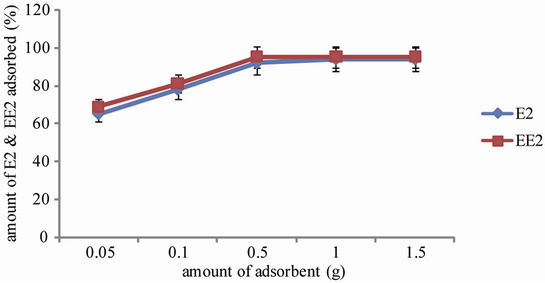
Figure 2. Percentage of E2 and EE2 adsorbed with adsorbent dose.

Table 2. Pseudo first and second-order kinetic of adsorbent GAC.
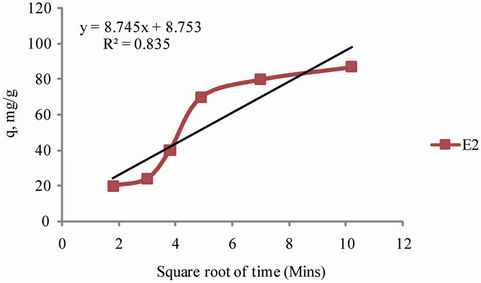 (a)
(a)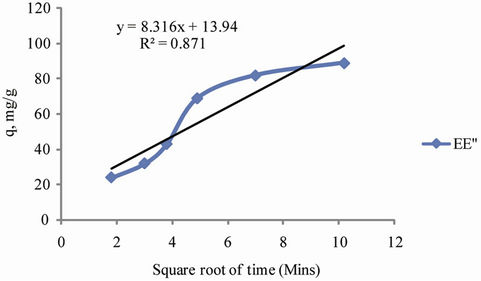 (b)
(b)
Figure 3. (a) Intra-particle kinetic model plot for E2; (b) Intra-particle kinetic model plot for EE2.
and hence can be attributed to the boundary layer diffusion of E2 and EE2 on the external surface of the activated carbon [28]. The last stage is where intra particle diffusion kinetics starts to slow down as a result of the lower adsorbate concentration in the aqueous solution. The middle stage (curved part) is where the intra-particle diffusion kinetics is controlled.
3.4. Effect of Temperature
The effects of temperature on the adsorption of E2 and EE2 were evaluated at temperatures of 15˚C, 20˚C, 25˚C and 30˚C, keeping other experimental conditions constant. The sorption processed showed increase with increasing temperature. The thermodynamic parameters associated with the sorption process such as changes in Gibb’s free energy ( ), enthalpy (
), enthalpy ( ) and entropy (
) and entropy ( ) were evaluated from the given Equations (6), (7) and (8):
) were evaluated from the given Equations (6), (7) and (8):
 (6)
(6)
 (7)
(7)
 (8)
(8)
where R is universal gas constant, T is the temperature in Kelvin (0K) and KD =  = quantity of adsorbate that adsorbed onto the adsorbent l/g. The plot of lnKD vs 1/T gave a straight line with
= quantity of adsorbate that adsorbed onto the adsorbent l/g. The plot of lnKD vs 1/T gave a straight line with  and
and  values obtained from the slope and intercept of the graph respectively. The thermodynamic parameters obtained from the graph are shown in Table 3. It can be seen that the values of enthalpy for both E2 (84.50 kJ/mol) and EE2 (90 kJ/mol) indicate a rather chemical nature of the sorption process. Similar data were obtained by Al-Degs et al., 2008 [29], for the sorption of dyes onto activated carbon. The positive entropy values of 34 and 36 J/mol K for E2 and EE2 respectively, suggest an increased randomness after the adsorption process.
values obtained from the slope and intercept of the graph respectively. The thermodynamic parameters obtained from the graph are shown in Table 3. It can be seen that the values of enthalpy for both E2 (84.50 kJ/mol) and EE2 (90 kJ/mol) indicate a rather chemical nature of the sorption process. Similar data were obtained by Al-Degs et al., 2008 [29], for the sorption of dyes onto activated carbon. The positive entropy values of 34 and 36 J/mol K for E2 and EE2 respectively, suggest an increased randomness after the adsorption process.
3.5. Adsorption Isotherms
The isotherms studies help to provide understanding of how the adsorbed molecules distribute between the aqueous phase and the solid phase and also in modeling design parameters. The equilibrium data obtained in this research was analysed using the Langmuir and Freundlich adsorption isotherm models as shown in Equations (9) to (10) respectively [30,31]:
 (9)
(9)
 (10)
(10)
where qe is the amount of adsorbate adsorbed per unit mass of adsorbent (mg/g), Ce the equilibrium concentration, qm, b, Kf and n are empirical constants. For the Langmuir equations, qm corresponds to the surface concentration at monolayer coverage and b relates to the energy of the adsorption. For the Freundlich equation, Kf is an estimation of the adsorption capacity while 1/n is a measure of the strength of adsorption. Table 4 represents the Langmuir, and Freundlich, coefficients for single solute adsorption isotherms and their corresponding correlation coefficients after evaluating the straight plots of Equations (9) and (10). The data obtained showed that

Table 3. Thermodynamic properties for E2 and EE2 at pH 7, temperature 20˚C to 35˚C.

Table 4. Langmuir and Freundlich isotherm parameters.
there was no perfect fit of the experimental data to any of the models. However the better fits were obtained for the Langmuir isotherm model. This suggests that the adsorption of E2 and EE2 occurs in localized sites. However, Freundlich adsorption isotherm which described the multilayer adsorption also showed less, but fairly good fit. In a previous work by the author [7], the Freundlich isotherm gave a better fit to Langmuir suggesting a multilayer adsorption. This could have been due to the effects of organics present in the wastewater. In this research the adsorption was a single solute adsorption in aqueous solution. For Freundlich isotherm, if n value is below unity then the adsorption is a chemical process; otherwise, the process is a physical process. All the n values obtained for E2 and EE2 are less than unity which support the adsorption of E2 and EE2 onto the GAC by chemisorption. This was also supported by the thermodynamic and desorptions studies in Sections 3.4 and 3.6.
3.6. Adsorption-Desorption Studies
In trying to further understand the adsorption mechanism; adsorption-desorption test was carried out. It provides an insight into the type of bonding that exist between the adsorbate and the adsorbent. The desorption experiments were carried out using sodium hydroxide, hydrochloric acid and DI water. The amount of E2 and EE2 desorbed during the experiments are depicted in Figure 4. It can be seen that the percentage amounts of E2 and EE2 desorbed are relatively small, ranging from <1% to 3.4%, suggesting that the interaction between the adsorbates and the adsorbent is more of a chemical type interaction. In attempting to draw conclusion for the mechanism of adsorption of E2 and EE2 to GAC; it can be inferred that the mechanism of adsorption is by mainly chemisorptions supported by some physical attraction (van der Waal’s forces).
4. Conclusion
The kinetics and thermodynamic properties of the ad-
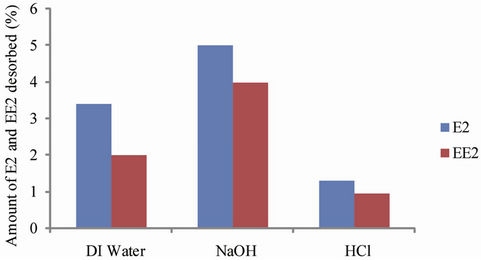
Figure 4. Percentage of E2 and EE2 desorbed in HCl, NaOH and DI water.
sorption of E2 and EE2 unto granular activated carbon were investigated. The removal of E2 and EE2 were favoured at acidic and neutral pHs, with optimum removal at neutral pH. The adsorption of E2 and EE2 showed good fit with the pseudo second order rate equation and the Langmuir adsorption isotherm model. The intra-particle diffusion plot showed boundary layer diffusion of the adsorbates onto the external surface of the adsorbent. The Gibbs free energy of adsorption were –16.68 kJ/mol and –17.34 kJ/mol for E2 and EE2 respectively, indicating that the sorption processes were spontaneous. The values of enthalpy for both E2 (84.50 kJ/mol) and EE2 (90 kJ/mol) indicated a chemical nature of the sorption process. The isotherm, thermodynamic and desorption data obtained all supported that the mechanism of adsorption of E2 and EE2 to be mainly chemisorptions supported by some van der Waal’s forces.
5. Acknowledgements
The author will like to thank Severn Trent Water Limited for their support.
REFERENCES
- N. Nakada, T. Tanishima, H. Shinokara, H. Kiri and H. Takada, “Pharmaceutical Chemicals and Endocrine Disrupters in Municipal Wastewater in Tokyo and Their Removal during Activated Sludge Treatment,” Water Research, Vol. 40, No. 17, 2006, pp. 3297-3303. doi:10.1016/j.watres.2006.06.039
- M. J. Gomez, M. J. Martinez Bueno, S. Lacorte, A. R. Fernandez-Alba and A. Aguera, “Pilot Survey Monitoring Pharmaceuticals and Related Compounds in a Sewage Treatment Plant Located on the Mediterranean Coast,” Chemosphere, Vol. 66, No. 6, 2007, pp. 993-1002. doi:10.1016/j.chemosphere.2006.07.051
- A. O. Ifelebuegu, “The Fate and Behavior of Selected Endocrine Disrupting Chemicals in Full Scale Wastewater and Sludge Treatment Unit Processes,” International Journal of Environmental Science and Technology, Vol. 8, No. 2, 2011, pp. 245-254.
- K. Omotoyo, H. Daniel and T. Maya, “Review in Removing Pharmaceuticals and Endocrine Disrupting Chemicals Compounds from Wastewater by Photocatalysis,” Biotechnology, Vol. 82, 2007, pp.121-134.
- A. J. Jafari, R. P. Abasabad and A. Salehzadeh, “Endocrine Disrupting Contaminants in Water Resources and Sewage in Hamadan City of Iran,” Iranian Journal of Environment Health Science and Engineering, Vol. 6, No. 2, 2009, pp. 89-96.
- K. J. Choi, S. G. Kim, C. W. Kim and S. H. Kim, “Effects of Activated Carbon Types and Service Life on the Removal of Endocrine Disrupting Chemicals: Amitrol, Nonyphenol and Bisphenol-A,” Chemosphere, Vol. 58, No. 11, 2005, pp. 1535-1545. doi:10.1016/j.chemosphere.2004.11.080
- A. O. Ifelebuegu, J. N. Lester, J. Churchley and E. Cartmell, “Removal of an Endocrine Disrupting Chemical (17alpha-Ethinyloestradiol) from Wastewater Effluent by Activated Carbon Adsorption: Effects of Activated Carbon Type and Competitive Adsorption,” Journal of Environmental Technology, Vol. 27, 2006, pp. 1343-1349. doi:10.1080/09593332708618748
- A. K. Kumar and S. V. Mohan, “Endocrine Disrupting Synthetic Estrogen (17α-Ethinyloestradiol) Removal from Aqueous Phase through Batch and Column Sorption Studies: Mechanistic and Kinetic Analysis,” Desalination, Vol. 276, 2011, pp. 66-74. doi:10.1016/j.desal.2011.03.022
- V. S. Muhandiki, Y. Shimizu, Y. A. F. Adou and S. Matsui, “Removal of Hydrophobic Micro_Organic Pollutants from Municipal Wastewater Treatment Plant Effluent by Sorption onto Synthetic Polymeric Adsorbent: Upflow Column,” Environmental Technology, Vol. 29, No. 3, 2008, pp. 351-361. doi:10.1080/09593330802102330
- E. K. Putra, R. Pranowo, J. Sunarso, N. Indraswati and S. Ismadji, “Performance of Activated Carbon and Bentonite for Adsorption of Amoxicillin from Wastewater: Mechanism, Isotherms and Kinectics,” Water Research, Vol. 33, No. 9, pp. 2419-2430.
- A. Rossner, S. S. Snyder and D. R. U. Knappe, “Removal of Emerging Contaminants of Concern by Alternative Adsorbent,” Water Research, Vol. 43, No. 15, pp. 3787- 3796. doi:10.1016/j.watres.2009.06.009
- F. G. Braga, S. Pinto and M. C. G. Antunes, “Comparative Study of 17β-Estradiol Removal from Aqueous Solutions Using Pine Bark and Almond Shell as Adsorbents,” Microchimica Acta, Vol. 173, No. 1-2, 2011, pp. 111- 117. doi:10.1007/s00604-010-0531-x
- I. Ismail, S. Enas and D. Jamal, “Kinetics, Equilibruim and Thermodynamics of the Sorption of Tetrabromobisphenol A on Multiwalled Carbon Nanotubes,” Applied Surface Science, Vol. 256, No. 23, 2010, pp. 7246- 7252. doi:10.1016/j.apsusc.2010.05.059
- A. O. Ifelebuegu and P. C. Ezenwa, “Removal of Endocrine Disrupting Chemicals in Wastewater Treatment by Fenton-Like Oxidation,” Water, Air and Soil Pollution, Vol. 217, 2011, pp. 213-220. doi:10.1007/s11270-010-0580-0
- W. K. Chan, J. Jouet, S. Heng, K. L. Yeung and J. Schrotter, “Membrane Contactor/Separator for an Advanced Ozone Membrane Reactor for Treatment of Recalcitrant Organic Pollutants in Water,” Journal of Solid State Chemistry, Vol. 189, 2012, pp. 96-100. doi:10.1016/j.jssc.2012.01.023
- J. Sin, S. Lam, A. R. Mohamed and K. Lee, “Degrading Endocrine Disrupting Chemicals from Wastewater by TiO2 Photocatalysis: A Review,” International Journal of Photoenergy, Vol. 2012, 2012, pp. 1-23. doi:10.1155/2012/185159
- ASTM Book of Standards, “Refractories, Activated Carbon, Advanced Ceramics,” American Society for the Testing of Materials, Philadelphia, 2005.
- Standing Committee of Analyst (SCA), “The Determination of Steroid Estrogens in Environmental and Wastewater Using Chromatography and Mass Spectrometery,” Environment Agency, Bristol, 2005.
- R. Kanda and J. Churchley, “Removal of Endocrine Disrupting Compounds during Conventional Wastewater Treatment,” Environmental Technology, Vol. 29 No. 3, 2008, pp. 315-323. doi:10.1080/09593330802099874
- M. Clara, B. Strenn, E. Saracevic and N. Kreuzinger, “Adsorption of Bisphenol-A, 17β-Estradiole and 17α- Ethinylestradiole to Sewage Sludge,” Chemosphere, Vol. 56, No. 9, pp. 843-851. doi:10.1016/j.chemosphere.2004.04.048
- K. S. Kumar, S. V. Mohan and P. N. Sarma, “Sorptive Removal of Endocrine Disruptive Compound (Estriol, E3) from Aqueous Phase by Batch and Column Studies: Kinetic and Mechanistic Evaluation,” Journal of Hazardous Material, Vol. 164, 2009, pp. 820-828. doi:10.1016/j.jhazmat.2008.08.075
- S. V. Mohan, S. Shailaja, M. Rama Krishna and P. N. Sarma, “Adsorptive Removal of Phthalate Ester (Di-ethyl phthalate) from Aqueous Phase by Activated Carbon: A Kinetic Study,” Journal of Hazardous Materials, Vol. 146, No. 1-2, 2007, pp. 278-282. doi:10.1016/j.jhazmat.2006.12.020
- D. I. Mall, V. C. Srivastava and N. K. Agarwal, “Removal of Orange-G and Methyl Violet Dyes by Adsorption onto Bagasse Fly Ash-Kinetic Study and Equilibrium Isotherm Analyses,” Dyes and Pigments, Vol. 69, 2006, pp. 210-223. doi:10.1016/j.dyepig.2005.03.013
- M. H. Kalavathy, T. Karthikeyan, S. Rajgopal and L. R. Miranda, “Kinetics and Isotherm Studies of Cu(II) Adsorption onto H3PO4-Activated Rubber Wood Sawdust,” Journal of Colloid and Interface Science, Vol. 292, 2005, pp. 354-362. doi:10.1016/j.jcis.2005.05.087
- S. Langergren, “About the Theory of So-Called Adsorption of Soluble Substances,” Kungliga Svenska Vetenskapsakademiens Handlingar, Vol. 24 No. 4, 1898, pp. 1-39.
- Y. S. Ho, W. T. Chiu and C. C. Wang, “Regression Analysis for the Sorption Isotherms of Basic Dyes on Sugarcane Dust,” Bioresource Technology, Vol. 96, 2005, pp. 1285-1291. doi:10.1016/j.biortech.2004.10.021
- W. J. Weber and J. C. Morris, “Kinetics of Adsorption on Carbon from Solution,” Journal of the Sanitary Engineering Division, Vol. 89, 1963, pp. 31-40.
- K. Kumar and S. V. Mohan, “Removal of Naturral and Synthetic Endocrine Disrupting Estrogens by Multi-Walled Carbon Nanotubes (MWCNT) as Adsorbent: Kinetic and Mechanistic Evaluation,” Separation and Purification Technology, Vol. 87, 2012, pp. 22-30. doi:10.1016/j.seppur.2011.11.015
- Y. S. Al-Degs, M. I. El-Barghouthi, A. H. El-Sheikh and G. M. Walker, “Effect of Solution pH, Ionic Strength, and Temperature on Adsorption Behavior of Reactive Dyes on Activated Carbon,” Dyes Pigments, Vol. 77, 2008, pp. 16-23. doi:10.1016/j.dyepig.2007.03.001
- I. Langmuir, “The Adsorption of Gases on the Plane Surfaces of Glass, Mica, and Platinum,” Journal of American Chemical Society, Vol. 40, 1918, pp. 1361-1403. doi:10.1021/ja02242a004
- H. M. F. Freundlich, “Über Die Adsorption in Lösungen,” Zeitschrift für Physikalische Chemie, Vol. 57, 1906, pp. 385-470.

